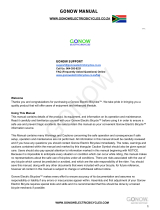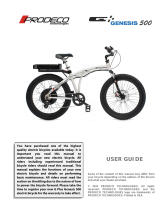
Please refer to the beginning of this guide for information about using
and charger.
•The battery indicator will instruct the rider about when a
recharge is necessary.
•Charging time from empty is about 4-6 hours.
•The battery must only be charged with the charger provided.
Aftermarket chargers not meeting the same specifications may
cause internal battery damage.
•Do not charge the battery with a non-genuine charger, or one not
designed for lithium-ion batteries.
•To charge, connect cable to battery body and a 110V outlet
•The battery has 3 LEDs to indicate the charging status
Maintenance and cleaning
•
Do not wash the bicycle using high water pressure to prevent water
from penetrating the electrical system and critical bicycle
Clean all painted parts with light cleaning products and wipe with a
dry cloth.
•Once rinsed, lightly grease the chain and moving components.
•
Be sure to use lubricant oil for bicycles only. Do not grease the rims,
tires, disc restraints, pads, battery, or controller.
•
It is recommended to replace the brake pads occasionally (based on
frequency of use)
Recommended technical inspections
•Chassis: inspect and repair any cracks or openings in the welds.
•
Tighten the following parts: fork, handlebar, brake handles, seat bar,
pedals, suspension, porter, folding bracket, wheel connection, drive
wheel, gear shifter, flashlight bracket, battery bracket, rail, rotor
(disc), controller cover, mud guards (wings).
1. Connect the charging cable to the battery charger input
2. Connect the outlet to a 110V power source.
3. Verify all hinges/bolts are secure
4. Enjoy once charged!
General information and battery precautions
1. While the battery is detached from the bike, please refrain from touching the
battery connectors (+ /-), especially if hands are wet, or when touching metal,
for fear of electrocution or short.
2.
The battery must be charged at the correct polarity. Charging the battery in incorrectly
may significantly reduce the duration of its life. Please follow the enclosed charging
guidelines to ensure safe use, and battery longetivity.
3. The charging cable must be connected between the charger and the battery securely.
4.
First attach the feed wire to the charger, and then insert the 110V wall end into the
After charging is finished, first pull the plug from the outlet, and then feed the plug from
the charger to the battery, through the body of the charger.
6. Keep your charger and battery in a safe place, away from child’s reach.
7. Do not use the battery before it is fully charged. Doing so can
severely shorten the battery’s lifespan.
8.
Do not charge the battery with a non-genuine charger. Use only the charger provided
Avoid charging in moist and/or humid conditions. Keep the battery stored safely to
prevent damage
10. Do not cover the charger while in use, as it may overheat or burn.
11. Use the charger only in an enclosed structure.
12.
If the charger begins to smell, or the charger/battery get very hot, seize charging
immediately and contact a technician.
13. NEVER CHARGE THE BICYCLE BATTERY UNATTENDED
14.
Do not charge under direct sunlight or in humid conditions, as it may damage the
batteries electrical system.













